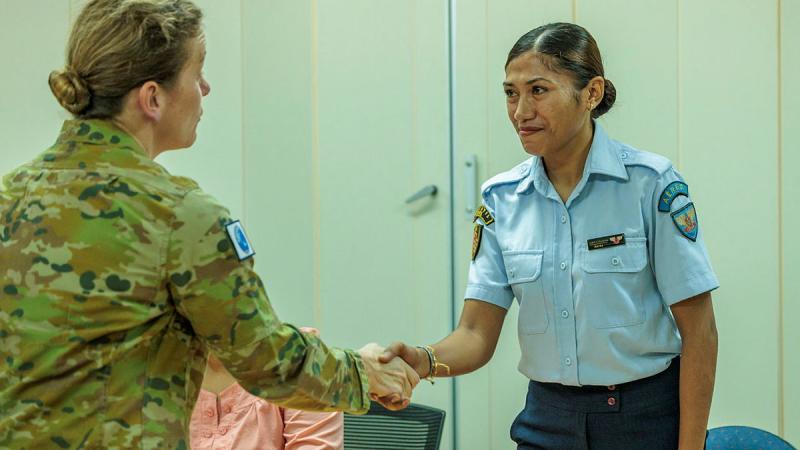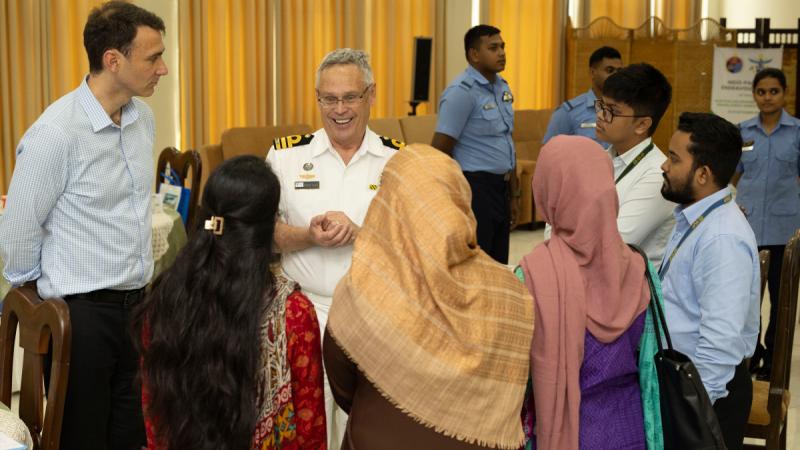24 July 2025
It’s found everywhere throughout South-East Asia, grows up to one metre a day and punches holes through garden pavers.
Now sappers from 1st Combat Engineer Regiment are hoping bamboo can reshape Royal Australian Engineer doctrine after a joint-training activity in the Philippines during May and June.
Australians were there to help Philippine sappers, mostly from 504th Combat Engineer Battalion, transition from construction to combat engineering.
While the Aussies taught things such as building field obstacles, explosive breaching and search techniques, their Philippine counterparts taught the Australians how bamboo makes a sapper’s job easier.
Instead of making fighting-pit revetments with corrugated iron and star pickets, Filipinos use bamboo cut into quarters to make the walls, held in place with bamboo stakes.
Section commander Lance Corporal Bailey Young said not having the logistics burden of moving heavy stores wasn’t the only benefit.
“I found reveting a pit with bamboo is faster and easier than reveting it by our doctrine,” Lance Corporal Young said.
Philippine sappers also showed the Aussies how to make bamboo Bangalore torpedos – long explosive devices for clearing obstacles.
Bamboo is split – explosives are placed inside and compacted with dirt – before being zip-tied back together.
'I’ve been a sapper for eight years, I’ve never seen anyone make explosive accessories out of bamboo.'
Lance Corporal Young said the tamping of explosives on bamboo helps the material to blast into chunks without splintering, creating good bamboo shrapnel for clearing things such as wire obstacles.
“I’ve been a sapper for eight years, I’ve never seen anyone make explosive accessories out of bamboo,” Lance Corporal Young said.
Australians make Bangalore torpedos from star pickets – weighing up to 12kg when complete, while the bamboo version doesn’t exceed about 5kg.
That makes it easier for sappers to move them, usually under fire, so they can be placed for a breach.
While Aussies were discovering the usefulness of bamboo, the Filipinos were keen to use Australian hand-held mine detectors and get better at demolitions.
Lance Corporal Jaidyn Tighe’s section ran the breach training for about 140 Philippine sappers, who were a mix of veterans from the Siege of Marwari and younger soldiers.
“They didn’t have much experience in demolitions and especially not in things like electronic fuses. For many, it was their first time,” Lance Corporal Tighe said.
Throughout the training, Lance Corporal Young said Filipinos would ask for extra notes and information to study outside work hours.
“Sometimes they put Australians to shame by how quickly they’re able to learn,” he said.
During search training, Lance Corporal Young saw his Philippine counterparts take about three days to reach a level similar to a section commander’s role in the Royal Australian Engineers.
That meant they could conduct a route search with an isolation party and organically provide a search commander, whereas Australian sappers would train for a week to attain just the individual skills.
Lance Corporal Young said bonding with Philippine sappers was easy when they realised sections in both armies had people who fit similar personalities.
They could recognise the other section’s funny guy, cool guy and quiet guy.
“You might see the funny guy sitting off to the side not working, you could make a joke out of it, and all the Filipinos would join in. Then we’d get the same thing back,” Lance Corporal Young said.
The activity culminated with the force operating as a joint combat engineer battalion, with each platoon having two or three Philippine sections and one of Australians, led by an Aussie or Philippine officer.
Lieutenant Alastair Wuth, an engineer troop commander on his first overseas Army trip, said commanding such a platoon meant understanding how each army did things and meeting in the middle.
'To physically show them something was a good way to run through a set of orders.'
One case was using the Australian section Minimi machine gun – something Philippine engineer sections don’t have – for platoon defence.
Platoons took on the Philippine practice of cooking in tactical situations. A Filipino soldier would cook for the platoon while an Australian was rotated to help, learning how to cook rice inside a bamboo shoot and make pork adobo.
Lieutenant Wuth also gave non-traditional orders using fewer words and more symbology.
“They pick up things a lot faster than we do,” he said. “So to physically show them something was a good way to run through a set of orders. We basically used more ROC (rehearsal of concept) drills.”
By the time things finished, Lance Corporal Young had Filipinos thanking him for training them to survive a near-peer conflict.
The Australians now hope to train with bamboo in Darwin, given 1 Brigade’s littoral role would mean less logistics support and a need to use local resources.
“I’d want to see that introduced into one of our engineering PAMs (doctrines), as a suggestion for resources we could use,” Lieutenant Wuth said.
“It has withstood the test and it definitely can work.”
The activity was part of the Joint Australian Training Team – Philippines (JATT-P) program.
In 2025, JATT-P will involve more than 20 training activities and exchanges between the ADF and Philippine armed forces, more than double the events last year.


